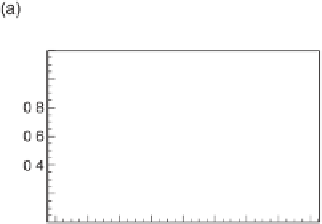Biology Reference
In-Depth Information
Figure 9.5
(a) Extrasystolic restitution and post-extrasystolic potentiation
responses showing cytosolic Ca
2+
concentration (
M, ordinate) as a function of
time (s, abscissa) predicted by the common pool ventricular myocyte using the
stimulus protocols described in the text. (b) As in (a), but with isometric force
(N/mm
2
) predicted from the Ca
2+
transients in (a), force plotted on the
ordinate. (c) Normalized peak RyR release flux (ordinate) as a function of
membrane potential (mV, abscissa) for rat ventricular myocytes (symbols) and
for the common pool model (solid line). (d) Behavior of the common pool
ventricular myocyte model when Ca
2+
-dependent inactivation of LCCs is
adjusted to be stronger than voltage-dependent inactivation as per data of Linz
and Meyer [38]. Note instability of action potentials.
µ
stimulus (denoted S3) is delivered 3 s after the corresponding S2
stimulus. Responses to the S3 stimuli delivered 3 s after the correspon-
ding S2 stimuli
a
and
b
are labeled in figures 9.5a-b as
a
' and
b
',
respectively. As seen experimentally, a small extrasystolic response to S2
leads to a greater response to S3, an effect known as post-extrasystolic
potentiation [33].
S2 responses are seen to increase in amplitude as a function of the
S2 interval. This property is known as extrasystolic restitution and, in
the model, is determined primarily by the rate of recovery of the RyR
from adaptation following opening and release of Ca
2+
from the JSR [32].
S3 responses are seen to decline in amplitude depending on the


































































































Search WWH ::

Custom Search